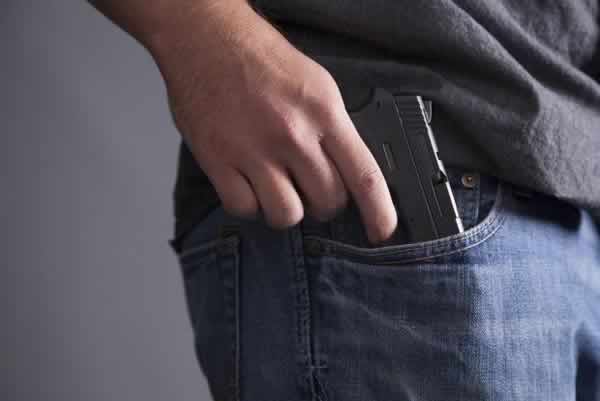Savage Model 1907
10 Quick Shots from an Early 20th Century Pocket Pistol
Before concealed carry was the norm, Savage Arms produced the Savage Model 1907 semi-automatic pocket pistol in .32 ACP is from 1907 until 1920.
Although smaller in size, it is derived from the .45 semi-automatic pistol Savage submitted to the 1906-1911 US Army trials to choose a new semi-automatic sidearm. After several years of testing the Savage pistol was one of two finalists but ultimately lost to Colt, which became famous as the Colt Model 1911.

Savage felt that a scaled down pocket pistol would be a better seller than a large bore handgun so the .45 ACP model never made it into Savage’s consumer catalog. Some gun collectors speculated how the .45 Savage would have been received if it was put into wide distribution. There was no need to wonder how the 1907 .32 fared. It was a home run and Savage ultimately produced 235,000 model 1907 pistols.
Design
Something cool about this pocket pistol is that its also a striker-fired gun. From the looks of the safety it seems to be external, but its really a cocking lever.
Model 1907s made from 1913 until 1917 had a collared barrel and a loaded chamber indicator, allowing the shooter to tell by touching the shell ejection port whether a cartridge was chambered. The Model 1907 uses no screws (even the grips snap into place) and is simple to strip. The grips were made from gutta-percha, though some early production examples had metal grips. In 1912 the Model 1907 underwent a major design revision modifying almost every major component.
As with most semi-automatics, the pistol is readied for firing by pulling back and releasing the slide, which inserts a cartridge into the chamber and cocks the pistol. The recoil from firing a cartridge automatically extracts and ejects the empty shell, cocks the firing pin and loads another cartridge into the chamber, ready for firing.
It was chambered for the .32 ACP cartridge, which was popular at the time and considered a fairly potent round. With its 71-grain FMJ bullet moving at about 900 fps, it would penetrate 5 inches when fired into stacked 0.875-inch soft-pine boards from 15 feet, a standard test at the time.
That was good performance compared to the .32 S&W and .38 S&W cartridges, which were also used in small-framed pocket revolvers of the period.

The pistol had many unique features.
- The circular knurled knob at the top is not a hammer as the model 1907 is a striker-fired pistol. The knurled knob is actually a cocking indicator. As pictured above the knob indicates that the pistol is not cocked. If it was in the rearward position then the striker is cocked.
- The slide rides inside the frame, as do the modern CZ pistols, rather than riding on top or outside of the frame.
- As the slide rides inside the frame, little of the slide is left to grasp in order to rack the slide and charge the pistol. To help that function Savage put large and well spaced cocking serrations on the slide to assist with its manipulation.
- The magazine holds 10 rounds in a double stack configuration. I’ll bet you didn’t realize that double stack magazine go all the way back to the early days of the last century.
- The magazine release sits at the bottom of the front strap.
One is supposed to be able to operate the release using your little finger. - The safety lever swings up to make the pistol safe.
- The sights are small and representative of an era where shooting was done quickly without taking the time to obtain an ultra precise sight picture.
Taking Pistol Apart
Taking the pistol apart is as easy as pulling back the slide fully and put the safety lever to lock the slide in position. Turn the breech block containing the cocking lever (hammer) clockwise about 45 degrees, then, squeezing backward on the cocking lever, fully rotate the breech block 90 degrees, which lets you pull it straight back and remove it from the slide.
With a firm grip on the slide, move the safety to “fire” and pull the trigger. The slide can be moved forward off the frame. The barrel can now be removed.
Putting the pistol back is in the reverse order, but you must squeeze the cocking lever hard as you reinsert the breech block, and make sure you put it in the same way it came out.
Out on the Range

For the lucky ones that had a chance to shoot one, all stated the 1907 was very pleasant to shoot. The .32 ACP has a minimum of recoil but before we look at the target. Just so you know the sights are really tiny and the pistol is over 100 years old.
The target above was shot with Remington FMJ ammo at 21 feet from an unknown shooter. This pocket pistol was designed for close quarter contact, they stated they did not fire it beyond the 7 yard marker. Shots were at the middle and top two diamonds. The rounds in the southern hemisphere were shot at the equatorial target. Still, for what this pistol is designed for, it serves the purpose well.
Some shots were from a sandbag rest from the bench, the results wasn’t bad. This shooter produced a decent five-shot groups with the Remington ammo. The best measured 1.64 inches, and the average was 1.98 inches—again not too bad for a gun over 100 years old. The recoil was non-existent and rapid firing was a breeze.
So if you ever get a chance to get this pocket pistol that you can pipe with 10+1 from the early 20th century, why not!
Savage 1907 Specs
Caliber: .32 ACP
Barrel: 3.75 inches
OA Length: 6.5 inches
Weight: 19 ounces (empty)
Grip: Checkered rubber
Sights: Blade front, integral rear
Action: SA
Finish: Blued
Capacity: 10+1
MSRP: N/A






